

Evolution- NBCNews.com. Future Evolution. Ward labels the species that have the potential to survive in a human-infested world.
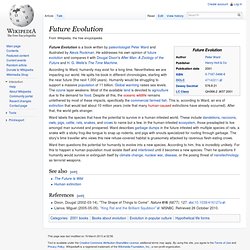
These include dandelions, raccoons, owls, pigs, cattle, rats, snakes, and crows to name but a few. In the human-infested ecosystem, those preadapted to live amongst man survived and prospered. Ward describes garbage dumps in the future infested with multiple species of rats, a snake with a sticky frog-like tongue to snap up rodents, and pigs with snouts specialized for rooting through garbage. The story's time traveller who views this new refuse-covered habitat is gruesomely attacked by ravenous flesh-eating crows. Ward then questions the potential for humanity to evolve into a new species. See also[edit] References[edit] Dixon, Dougal (2002-03-14).
Rodents could rule future animal kingdom - Technology & science - Science - Evolution - NBCNews.com. SEATTLE — It's not that Peter Ward has a special fondness for rats.
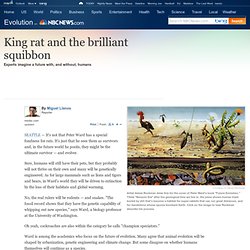
It's just that he sees them as survivors and, in the future world he posits, they might be the ultimate survivor — and evolver. Sure, humans will still have their pets, but they probably will not thrive on their own and many will be genetically engineered. As for large mammals such as lions and tigers and bears, in Ward's world they will be driven to extinction by the loss of their habitats and global warming. No, the real rulers will be rodents — and snakes. "The fossil record shows that they have the genetic capability of whipping out new species," says Ward, a biology professor at the University of Washington. Oh yeah, cockroaches are also within the category he calls "champion speciators. " Ward is among the academics who focus on the future of evolution. Why dabble in what Dixon himself calls "speculative biology? " Gone will be the vast grasslands that gave rise to large mammals. The Future Is Wild. Last and First Men.
Last and First Men: A Story of the Near and Far Future is a "future history" science fiction novel written in 1930 by the British author Olaf Stapledon.
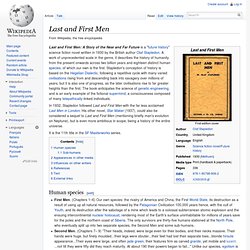
Ostatni i pierwsi ludzie. Ostatni i pierwsi ludzie (Last and First Men: A Story of the Near and Far Future) – powieść science fiction brytyjskiego autora Olafa Stapledona, wydana 1930 roku.

Dzieło bezprecedensowe w skali gatunku, autor opisuje historię ludzkości w okresie dwóch miliardów lat w którym to pierwszym i najbardziej prymitywnym gatunkiem są Pierwsi ludzie (czyli nasz własny gatunek), a także siedemnaście innych gatunków człowieka, które są coraz bardziej rozwinięte. W polskim przekładzie fragment powieści ukazał się w antologii Droga do science fiction. File:Last and First Men.pdf. Primeval. After Man: A Zoology of the Future. Man After Man: An Anthropology of the Future. Man After Man: An Anthropology of the Future- książka szkockiego paleontologa Dougala Dixona, wydana w 1990 roku.
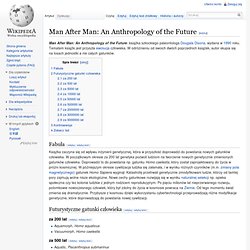
Tematem książki jest przyszła ewolucja człowieka. W odróżnieniu od swoich dwóch poprzednich książek, autor skupia się na losach jednostki a nie całych gatunków. Fabuła[edytuj | edytuj kod] Książka zaczyna się od wpływu inżynierii genetycznej, która w przyszłość doprowadzi do powstania nowych gatunków człowieka. Aftermath: Population Zero. Aftermath: Population Zero (also titled Aftermath: The World After Humans)[1] is a two-hour Canadian special documentary film that premiered on Sunday, March 9, 2008 (at 8:00 PM ET/PT) on the National Geographic Channel.
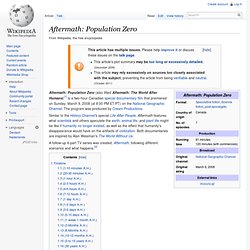
The program was produced by Cream Productions. Timeline[edit] The story begins on Friday, June 13, in an unspecified year. Life After People. Format[edit] The program does not speculate on how humanity may disappear, stipulating only that it has, and that it has done so suddenly, leaving everything behind including household pets and livestock that have to fend for themselves.
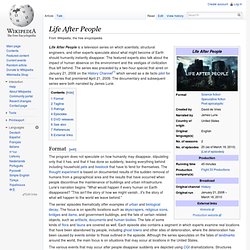
The thought experiment is based on documented results of the sudden removal of humans from a geographical area and the results that have occurred when people discontinue the maintenance of buildings and urban infrastructure. Lurie's narration begins: "What would happen if every human on Earth disappeared? "This isn't the story of how we might vanish...it's the story of what will happen to the world we leave behind.
" The various events that may occur after people disappear suddenly are depicted using CGI dramatizations. Tagline[edit] The World Without Us - Alan Weisman. The World Without Us. 20th Century Fox has purchased the rights to the book with the intent of creating a motion picture.[6] Background[edit]
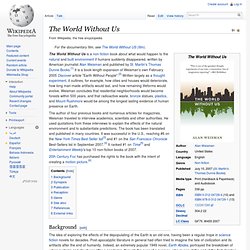
Świat bez nas - Weisman Alan za. Human extinction. Human extinction is the hypothesized end of the human species.

Various scenarios have been discussed in science, popular culture and religion (see End time). The scope of this article is existential risks. Humans are very widespread on the Earth, and live in communities that (while interconnected) are capable of some level of basic survival in isolation. Therefore, pandemics and deliberate killing aside, to achieve human extinction the entire planet would have to be rendered uninhabitable, with no opportunity provided or possible for humans to establish a foothold beyond Earth.
This would typically be during a mass extinction event, a precedent of which exists in the Permian–Triassic extinction event among other examples. Possible scenarios[edit] Severe forms of known or recorded disasters[edit] U.S. officials assess that an engineered pathogen capable of "wiping out all of humanity" if left unchecked is technically feasible and that the technical obstacles are "trivial". Other[edit]